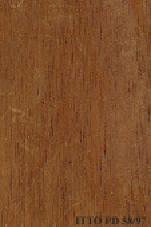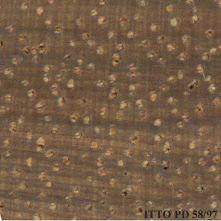
AGLAIA (Aglaia spectabilis)
Trade Name
Aglaia
Scientific Name
Aglaia spectabilis (Miq.) Jain & Bennet
Family
MELIACEAE
Common Names
Goji nui (Vietnam); Surian batu (Malaysia); Lantupak (Sabah); Nuk kuk (Laos); Mokken (West Irian); Bekak (Malaysia); Goji nep (Vietnam); Tasua bailek (Thailand); Mokken (Indonesia)
Scientific Name Synonyms
Amoora ridleyi King; Amoora gigantea Pierre; Aglaia ridleyi (King) Pannell; Aglaia gigantea (Pierre) Pellegrin
Description Of The Tree
Botanical Description
It is a medium-sized to fairly large tree up to 40 m tall. The bole is branchless for up to 18 m and up to 150 cm in diameter. The buttresses are up to 4 m high.
Natural Habitat
It is reported in primary and secondary rain forests, from the sea level up to 700 m of altitude.
Wood Identification
Anatomic Description Of Wood
Wood diffuse porous. Colored deposits in heartwood vessels. Tangential diameter of vessel lumina 100 to 200 micras. Vessel-ray pits similar to intervessel pits in size and shape. Simple perforation plates. Intervessel pits small, 7 micras or less. Paratracheal axial parenchyma scanty and/or vasicentric. Axial parenchyma bands more than 3 cells wide. Ray width 1 to 3 cells. Body ray cells procumbent with one row of upright and/or square marginal cells (Kribs-III). Septate fibers present.
-
 Wood Macro Photo Tangential Plane
Wood Macro Photo Tangential Plane
-
 Wood Micro Photo Of Transversal Section
Wood Micro Photo Of Transversal Section
Availability
Cites Status
Unrestricted
General Wood Description
Odor
The wood often has a fragrant, sometimes even pungent, odor when fresh, resembling both cedar and camphor.
Color
The heartwood is pale red to dark reddish-brown, sometimes turning to walnut-brown or chestnut-brown, usually distinctly demarcated from the pale yellow to pale red-brown sapwood.
COLOR INDEX (1=Black, 7=Light yellow,white)
2
Grain
The grain is interlocked, sometimes straight.
Texture
The texture varies from moderately fine to moderately coarse.
Natural Durability
The wood is rated as moderately durable even in contact with the ground.
Natural durability index (1= Very high durability, 7=Vey low durability)
3
Resistance To Impregnation
The heartwood is often very difficult to treat with preservatives, the sapwood is moderately easy to easy.
Wood Physical Properties
Basic Density or Specific Gravity (O.D. weight/vol. green) (g/cm³)
0.638679434
Air-dry Density (Weight and volume at 12%MC) (g/cm³)
0.71
Total shrinkage Tangential (Saturated to 0%MC) (%)
7.8
Total shrinkage Radial (Saturated to 0%MC) (%)
5.0
Drying Defects
Ease of Drying: Drying is slow and rather difficult. Boards of 15 mm thick take about 3 months to air dry. Drying Defects: Resin exudation is reported to be common, especially when drying at high temperatures. It is prone to cupping, bowing, springing and end checking. Usually there is little splitting, surface checking, staining and insect attack during drying. Kiln Schedules: Schedule proposed for Apitong.
Recommended Dry Kiln Schedule
JP-26
Dimensional stability ratio (Total Tangential Shrinkage %/Total Radial Shrinkage %)
1.5
Wood Chemical Properties
Wood Mechanical Properties
Bending Strength (MOR),12%MC (kgf/cm²)
1004
Compression parallel to fiber 12%MC (kgf/cm²)
552
Workability
Sawing
Sawing of this species is easy.
Rotary Veneer Cutting
Veneer may warp severely during drying.
Sliced Veneer
Veneer may warp severely during drying.
Machining
This species is easy to machine.
Planing
Because of its grain it requires sharp and fine set planes, however, planed surfaces are smooth and lustrous.
Turning
30
Nailing
It is reported to have a good nailing behavior.
Gluing
This species is easy to glue.
Finishing
Wood of this species is easy to finish.
REFERENCED USES
End Uses Summary
HOUSING GENERAL, boards, FURNITURE AND CABINETS, cabinets, PLYWOOD AND VENEER, TURNING, SPORTS, TOOLS, tool handles
General Housing
- 10 - Silica in Timbers
Boards
- 13 - Dry kiln schedules for commercial woods. Temperate and tropical. Section III. Latin American (Mexico, Central, and South America) Woods–Conventional Temperatures
Furniture Cabinets
- 21 - Tropical timbers of the world. Part III-Southeast Asian and Oceanian Species.
Cabinet
- 24 - Empire Timbers
Panels, Veneers
- 25 - Directory of Timber Trade Malaysia
Turning
- 30 - Embassy of Honduras in Japan
Sports
- 38 - Annual Review and Assessment of the World Timber Situation 1998-ITTO
Tools
- 42 - Utilización Industrial de Nuevas Especies Forestales en el Perú.
Tool Handles
- 43 - Maderas de Bolivia (Características y Usos de 55 Maderas Tropicales)
Please Provide Information To View Producer Information